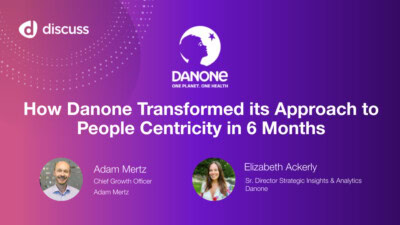Leveraging Customer Insights: Strategies for Maximizing Business Value

As businesses today face an increasingly competitive landscape, there’s a secret weapon that lies right in front of us – customer insights. Fueled by our digital era’s data-rich environment, these insights can pave the path to significant growth, profitability, and sustainability. Diving deep into this gold mine enables organizations to understand their customers better, build more effective products, and deliver exceptional experiences. In this blog post, we’ll unravel the potential of leveraging customer insights and discover winning strategies to maximize business value – a profound advantage not just for survival but for robust success in today’s fast-paced marketplace.
Our comprehensive article on “How To Make The Most Out Of Customer Insights” provides valuable strategies and tips for businesses to leverage customer insights effectively. It covers topics such as analyzing customer behavior, personalizing experiences, tailoring products and services, and creating extensive buyer personas. By following these techniques, businesses can better understand their customers and make informed decisions that drive growth and success.
Gathering Customer Insights Through Research
Gathering customer insights is a crucial undertaking for businesses looking to understand and maximize the value they provide to their customers. It involves obtaining data and information that helps identify pain points, drivers of satisfaction, customers’ journeys, and the unique assets of a company. While many companies still rely on basic customer analytics tools, there are more advanced strategies available to gather deeper insights.
One effective way to gather customer insights is through feedback surveys and reviews. By reaching out to customers directly and asking them about their experiences with the brand, businesses can gain valuable information about customer satisfaction levels, identify areas in need of improvement, and drive strategies for enhancing the overall customer experience.
Another valuable source of customer insights comes from phone calls. These interactions provide an opportunity to engage with customers on a personal level and uncover potential critical insights regarding their experiences with products, services, and brand perception. Phone calls allow businesses to listen actively to customers’ concerns, suggestions, and feedback, providing a deeper understanding of their needs and preferences.
One powerful technique for gathering customer insights is A/B testing, where different versions of a product or service are tested simultaneously on separate groups of customers. This approach helps measure the real-life consequences of different implementations and allows businesses to identify which features or options resonate most with their target audience. By analyzing the results of A/B tests, companies can gain valuable insights into customer preferences and tailor their offerings accordingly.
For example, let’s say an e-commerce company wants to determine whether offering free shipping or a discount code generates more sales. They can conduct an A/B test by randomly assigning half of their website visitors to see free shipping as an option while the other half sees the discount code. By measuring conversions and analyzing customer behavior during this test period, the company can gather insightful data on which option drives more purchases.
Now that we’ve explored some effective methods for gathering customer insights through research, let’s shift our focus to the importance of identifying customer needs and preferences.
Identifying Customer Needs and Preferences
Understanding customer needs and preferences is at the core of delivering a personalized and exceptional customer experience. By identifying what customers truly want, businesses can develop strategies that align with those desires, leading to increased satisfaction and loyalty.
One effective approach to identifying customer needs and preferences is through sentiment analysis. By analyzing customer feedback, social media mentions, and reviews, businesses can gain insights into customers’ feelings about their products or services. Sentiment analysis involves using natural language processing techniques to evaluate whether sentiments expressed by customers are positive, negative, or neutral. This data can help businesses understand how customers perceive their offerings and identify areas for improvement or further investment.
For instance, a hotel chain can use sentiment analysis to track online reviews and social media mentions about their properties. By understanding the sentiments expressed in these reviews – whether they are positive or negative – the hotel chain can identify common pain points raised by guests and take action to address them accordingly. This may involve improving service quality, enhancing facilities, or providing additional amenities that meet customer expectations.
Another effective way to identify customer needs and preferences is through social media monitoring. By tracking conversations on platforms like Facebook, Twitter, Instagram, and LinkedIn, businesses can gain insights into how the public perceives their brand and what topics resonate most with their target audience. Social media monitoring also offers an opportunity to engage with customers directly, respond to their inquiries or concerns promptly, and build meaningful relationships by demonstrating responsiveness.
Now that we have explored how gathering customer insights through research helps businesses understand their customers better, it’s time to move on to the next step: using market trends and consumer behavior tracking to gain valuable insights.
- Understanding customer needs and preferences is crucial for businesses to deliver a personalized and exceptional customer experience. Two effective approaches to identifying customer needs and preferences are sentiment analysis and social media monitoring.
- Sentiment analysis involves analyzing customer feedback, social media mentions and reviews to gain insights into customers’ feelings about products or services. By evaluating sentiments as positive, negative, or neutral through natural language processing techniques, businesses can understand how customers perceive their offerings and identify areas for improvement.
- Social media monitoring allows businesses to track conversations on platforms like Facebook, Twitter, Instagram, and LinkedIn. This helps gain insights into how the public perceives the brand and what topics resonate most with the target audience. It also provides an opportunity to engage with customers directly, respond promptly to inquiries or concerns, and build meaningful relationships.
- By utilizing these methods of gathering customer insights, businesses can better understand their customers, identify common pain points, take action to address them accordingly and build lasting loyalty. Additionally, incorporating market trends and consumer behavior tracking enhances understanding further. Overall, this understanding leads to improved strategies that align with customer desires and drive satisfaction.
Tracking Market Trends and Consumer Behavior
To stay ahead in today’s competitive business landscape, it’s essential to track market trends and understand consumer behavior. This allows businesses to identify emerging opportunities, anticipate customer needs, and adapt their strategies accordingly. Tracking market trends involves monitoring industry developments, technological advancements, economic factors, and social changes that can impact consumer preferences.
Understanding consumer behavior goes hand-in-hand with tracking market trends. By gaining insights into how consumers think, feel, and make purchasing decisions, businesses can tailor their offerings to meet specific customer needs and preferences. This requires collecting and analyzing data from various sources such as surveys, feedback channels, social media platforms, and website analytics.
For example, let’s consider a clothing retailer that observed a rising trend of sustainability-conscious consumers seeking eco-friendly fashion options. By tracking this market trend and understanding the values driving consumer behavior, the retailer could develop a line of sustainable clothing made from ethically sourced materials. This not only aligns with consumers’ values but also positions the business as a leader in a sustainable fashion.
On the other hand, some may argue that tracking market trends and consumer behavior is not necessary for every business. They might claim that smaller businesses or those operating in niche markets do not require extensive insights into market trends. However, it is important to remember that even niche markets are subject to constant change and evolving consumer preferences. By staying informed about these shifts, businesses can proactively adapt their products or services to remain relevant.
- A 2022 survey from Forrester Research showed that companies utilizing customer insights in their strategic planning enjoyed a 14% higher customer satisfaction rate compared to those that did not.
- According to McKinsey’s 2023 Business Analytics report, businesses that heavily utilize customer insights have been able to reduce their service costs by up to 20%.
- A Harvard Business Review study revealed that businesses using data-driven customer insights witness a decrease in marketing costs as high as 30%.
Applying Insights to Enhance Business Strategy
Once businesses have gathered customer insights through thorough monitoring of market trends and consumer behavior, the real value lies in effectively applying those insights to enhance their overall business strategy. This involves leveraging the gathered data and translating it into actionable steps that drive growth, customer satisfaction, and competitive advantage.
One way to apply customer insights is by improving the products or services offered. By identifying areas for enhancement based on customer feedback, businesses can prioritize product features or service elements that have the greatest impact on customer satisfaction. For example, an online retailer may notice through customer reviews and surveys that customers prefer faster shipping times over additional product discounts. Armed with this insight, the retailer can invest in streamlining their logistics and delivery processes to meet customer expectations.
Let’s consider a software company that tracks user behavior within its web application. By analyzing usage patterns and identifying pain points through user feedback, the company gains valuable insights to enhance the user experience. They may discover that users frequently struggle with a particular feature or find certain workflows inefficient. Armed with this understanding, the software company can focus on improving these aspects, resulting in a more intuitive and user-friendly product.
Another way to leverage customer insights is by personalizing marketing and communication strategies. Businesses can segment their customers based on demographic, behavioral, or psychographic characteristics and tailor their messaging to resonate with each segment’s specific needs and preferences.
Additionally, customer insights can inform pricing strategies by understanding consumers’ willingness to pay for value-added features or competitive pricing in the market. These insights allow businesses to optimize their pricing structure for maximum profit while ensuring they are still competitive in the marketplace.
Creating Targeted Services Based on Customer Insights
Understanding your customers is vital for the success of any business. By leveraging customer insights, companies can gain valuable knowledge about their target audience’s preferences, behaviors, and pain points. This information then becomes the foundation for creating targeted services that cater specifically to their needs.
To begin this process, it is crucial to gather comprehensive and accurate customer data through various channels such as surveys, interviews, and feedback mechanisms. The more data points collected, the better-equipped businesses are to uncover patterns and trends that provide insight into customer preferences.
For instance, consider a retail company that collects data on customer buying habits and preferences. By analyzing this data, they might discover that a significant portion of their customers in a specific age group prefer eco-friendly products. Armed with this insight, the company could develop a targeted service line focused solely on sustainable and environmentally friendly goods. This not only meets the unique needs of their customers but also enables them to differentiate themselves from competitors.
Once businesses have gathered sufficient customer insights, they can utilize segmentation techniques to divide their target market into distinct groups based on shared characteristics or interests. This segmentation allows businesses to tailor their services according to each group’s specific needs and preferences, resulting in more compelling offerings.
With targeted services in place, let’s explore how businesses can improve customer experience even further through data-driven tactics.
Improving Customer Experience with Data-Driven Tactics
In today’s highly competitive landscape, providing exceptional customer experiences is no longer just an option – it is an imperative for sustainable business growth. Data-driven tactics play a vital role in achieving this goal by enabling businesses to understand their customers on a deeper level and personalize interactions accordingly.
By combining customer insights with advanced analytics tools, businesses can gain a holistic view of their customers across all touchpoints. This comprehensive understanding allows for personalized messaging and recommendations tailored to individual preferences, increasing engagement and overall satisfaction.
Consider a digital streaming service that uses customer data to curate personalized recommendations based on viewing history, genre preferences, and ratings. This data-driven tactic not only enhances the user experience by providing relevant content but also increases customer loyalty and retention.
Furthermore, data-driven tactics can empower businesses to anticipate customer needs and pain points in advance. By tracking customer behavior and leveraging predictive analytics, businesses can proactively address issues and offer solutions, further enhancing the customer experience.
For instance, an e-commerce company that tracks customer browsing behavior might identify a trend of customers abandoning their shopping carts at the payment stage. Armed with this insight, the company could implement strategies to streamline the checkout process, such as optimizing website performance or simplifying payment options. These data-driven improvements can help reduce friction for customers and increase conversion rates.
Quantifying Business Impact of Customer Insight Strategies
Understanding the impact of customer insight strategies on business performance is essential for organizations looking to maximize their value. By quantifying the outcomes and benefits derived from these strategies, businesses can make informed decisions, allocate resources effectively, and optimize their overall approach.
To begin quantifying the business impact of customer insight strategies, it is crucial to establish clear objectives and key performance indicators (KPIs). These KPIs can vary depending on the specific goals of the organization. For example, a company may focus on increasing customer satisfaction, improving product development, or enhancing customer retention rates.
Once the objectives are defined, data collection becomes a critical component. This involves gathering relevant information from various sources such as customer surveys, feedback, purchase histories, and social media analytics. The collected data provides valuable insights about customer behavior, preferences, needs, and pain points.
Let’s consider an example to illustrate the process. A clothing retailer aims to improve its online shopping experience by gaining a deeper understanding of their customers’ preferences. They launched a customer survey to gather feedback on aspects like website navigation, product selection, and checkout process. Through this survey, they collect quantitative and qualitative data that reveals potential bottlenecks in the online shopping journey based on customer responses.
With this data in hand, businesses can employ advanced analytics techniques to identify patterns and trends. By analyzing the collected information using tools like machine learning algorithms and predictive modeling, businesses can uncover actionable insights that can drive decision-making processes.
Now comes the stage where businesses translate these insights into tangible results. Utilizing the uncovered insights, organizations can implement targeted marketing campaigns, personalized experiences, enhanced product offerings, or streamlined processes tailored to specific customer segments. These actions have the potential to improve customer satisfaction, increase sales conversion rates, foster long-term loyalty, and boost revenue streams.
Think of quantifying the business impact of customer insight strategies like conducting an experiment. By gathering relevant data, analyzing it carefully, and taking appropriate actions based on the findings, businesses can conduct experiments that optimize their operations and drive positive results.
To measure the actual impact of these strategies on business value, organizations need to monitor and track various metrics over time. This may involve monitoring changes in customer satisfaction scores, revenue growth rates, customer retention rates, or market share. Continuous monitoring allows businesses to assess the effectiveness of their efforts and make adjustments when necessary.
In conclusion, quantifying the business impact of customer insight strategies empowers organizations to improve their decision-making processes, align resources effectively, and maximize their overall value. By setting clear objectives, collecting relevant data, analyzing insights, implementing targeted actions, and monitoring key metrics, businesses can unleash the true potential of customer insights and drive meaningful outcomes. Through this continuous cycle of learning and adaptation, organizations position themselves for long-term success in today’s competitive landscape.
The Conversation Continues: Maximizing Consumer Value through Research and Insights
Remember, the pursuit of maximized consumer value is not a solitary crusade, but a shared endeavor. Discuss.io serves as the crucible where knowledge transmutes into action, where creativity finds fertile ground, and where, collectively, we can rewrite the very definition of customer value, one insightful discussion at a time.
Contact us today for a demo and discover how we can help you maximizer consumer value with the use of cutting edge technology and pioneering research practices.
Ready to unlock human-centric market insights?
Related Articles

5 Trends Shaping the Future of Qualitative Insights
By Jim Longo, Co-Founder & Chief Strategy Officer at Discuss Each year, the Greenbook Research Industry Trends (GRIT) Business &…
By Jim Longo, Co-Founder & Chief Strategy Officer at Discuss Each year, the Greenbook Research Industry Trends (GRIT) Business &…

Navigating Tomorrow: A Glimpse into the Future of Market Research in 2024
Author: Jim Longo, Co-founder & Chief Strategy Officer As a veteran with over 30 years in the market research industry,…
Author: Jim Longo, Co-founder & Chief Strategy Officer As a veteran with over 30 years in the market research industry,…

Qualitative Research: Understanding the Goal and Benefits for Effective Analysis
As market trends evolve at lightning speed in the age of digital transformation, having an intimate understanding of consumer desires…
As market trends evolve at lightning speed in the age of digital transformation, having an intimate understanding of consumer desires…



